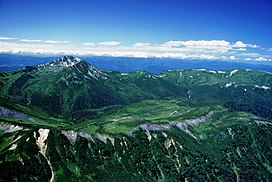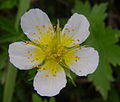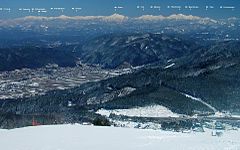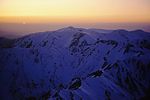Mount Kurobegorō
| Mount Kurobegorō | |
|---|---|
| Hắc bộ Ngũ Lang nhạc | |
 Mount Kurobegorō and Kumonotaira seen from Mount Suishō | |
| Highest point | |
| Elevation | 2,897.48 m (9,506.2 ft)[1] |
| Listing | List of mountains in Japan 100 Famous Japanese Mountains |
| Coordinates | 36°23′33″N137°32′24″E/ 36.39250°N 137.54000°E[2] |
| Naming | |
| Language of name | Japanese |
| Pronunciation | [kɯɾobeɡoroːdake] |
| Geography | |
| Parent range | Hida Mountains |
| Topo map | Geospatial Information Authority25000:1 tam vũ liên hoa nhạc[2] 50000:1 thương ヶ nhạc |
| Climbing | |
| Easiest route | Hike |
Mount Kurobegorō(Hắc bộ Ngũ Lang nhạc,Kurobegorō-dake)is one of the100 Famous Japanese Mountains,[3]reaching the height of 2,839.58 m (9,316 ft). It is situated inJapan'sHida MountainsinGifu PrefectureandToyama Prefecture.It was specified forChūbu-Sangaku National Parkon December 4, 1934.[4]
Outline
[edit]The origin of the mountain's name is the meaning that the stone rolls. It is called "gōro" in Japanese. This mountain is also located at the source of theKurobe River.Then it is called "Kurobe-Gorō".[3] On the hillside on the east side, there is bigCirquegeographical features that is the hollow where the shovel was scooped out. The upper part of this mountain is situated inTree lineregion,Siberian Dwarf PineandAlpine plantgrow naturally. There are quite a lot of kinds of alpine plants in the surrounding, and it is selected to "the 100 famous Japanese mountains of flower" by Sumie Tanaka.[5]
Mountaineering
[edit]In December 1931, Buntarō Katō of Japanese mountain climber climbed it alone.
Main ascent routes
[edit]There are several climbing routes to the top of the mountain.[6][7]
- Hietsu-shin-dō
- Kamioka-shin-dō
- Arimine-guchi
- The west Ginza diamond course (from Oritate – Mount Kurobegorō – toMount Yari)
There are the Ridge Line and Cirque routes from the Kurobegorō hut to the top.
Mountain hut
[edit]Thera are severalmountain hutsaround Mount Kurobegorō.[7]
- Kurobegorō hut(Hắc bộ Ngũ Lang tiểu xá,Kurobegorō-goya)– in the col between Mount Kurobegorō and Mount Mitsumatarenge (withCampsite)
- Tarōdaira hut(Quá lang bình phòng nhỏ,Tarōdaira-goya)– in the col between Mount Yakushi and Mount Tarō (with Campsite)
- Mitsumata mountain cottage(Tam vũ sơn trang,Mitsumata-sansō)– in the col between Mount Mitsumatagenge and Mount Washiba (with Campsite)
Alpine plant
[edit]A lot of Alpine plant are seen in the surrounding.
| Lilium medeoloides | Veratrum stamineum | Trollius japonicus | Geum pentapetalum | Geranium yesoemse |
|---|---|---|---|---|
 |
 |
 |
 |
 |
Geography
[edit]Nearby mountains
[edit]

| Image | Mountain | Elevation | Distance from the Top |
Note |
|---|---|---|---|---|

|
Mt. Yakushi Dược sư nhạc |
2,926.01 m (9,600 ft) | 8.5 km (5.3 mi) | 100 Famous Japanese Mountains |

|
Mt. Kitanamata Bắc ノ vũ nhạc |
2,662 m (8,734 ft) | 4.0 km (2.5 mi) | |

|
Mt. Kurobegorō Hắc bộ Ngũ Lang nhạc |
2,839.58 m (9,316 ft) | 0 km (0.0 mi) | 100 Famous Japanese Mountains |

|
Mt. Mitsumatarenge Tam vũ liên hoa nhạc |
2,841.23 m (9,322 ft) | 4.3 km (2.7 mi) | 300 Famous Japanese Mountains Boundary of three prefectures Toyama, Gifu and Nagano |

|
Mt. Kasa Nón ヶ nhạc |
2,897.48 m (9,506 ft) | 0 km (0.0 mi) | 100 Famous Japanese Mountains |

|
Mt. Yari Thương ヶ nhạc |
3,180 m (10,433 ft) | 11.2 km (7.0 mi) | 100 Famous Japanese Mountains |
Rivers
[edit]The mountain is the source of the followingrivers,each of which flows to theSea of Japan.[7]
- Nakanomata River (tributaryof theTakahara River)
- Kanekido River (tributary of theJōganji River)
- Uma River and Gorō River (tributaries of theKurobe River)
Scenery of Mount Kurobegorō
[edit]| fromMt. Kasa | from Mt. Washiba | fromMt. Yari | from Mt. Yari (sunset) |
|---|---|---|---|
 |
 |
 |
 |
References
[edit]- ^"Information inspection service of the Triangulation station"(in Japanese).Geospatial Information Authority of Japan,( núi cao - thương ヶ nhạc - tam vũ liên hoa nhạc ). Archived fromthe originalon June 9, 2009.RetrievedDecember 29,2010.
- ^ab"Map inspection service"(in Japanese). Geospatial Information Authority of Japan,( núi cao - thương ヶ nhạc - tam vũ liên hoa nhạc ).RetrievedDecember 29,2010.
- ^abKyūya Fukada(1982).100 Famous Japanese Mountains(in Japanese). The Asahi Shimbun Company. p. 198.ISBN4-02-260871-4.
- ^"Chūbu-Sangaku National Park".Ministry of the Environment (Japan).Archived fromthe originalon February 27, 2012.RetrievedDecember 29,2010.
- ^Sumie Tanaka (1995).100 Famous Japanese Mountains of flower(in Japanese).Bungeishunjū.pp. 221–224.ISBN4-16-352790-7.
- ^Alpen guide: Kamikōchi, Mount Yari and Mount Hotaka(in Japanese). YAMA-KEI Publishers. 2000.ISBN4-635-01319-7.
- ^abcMountain and plateau map of Mount Tsurugi and Mount Tate(in Japanese). Shobunsha Publications. 2010.ISBN978-4-398-75716-6.

